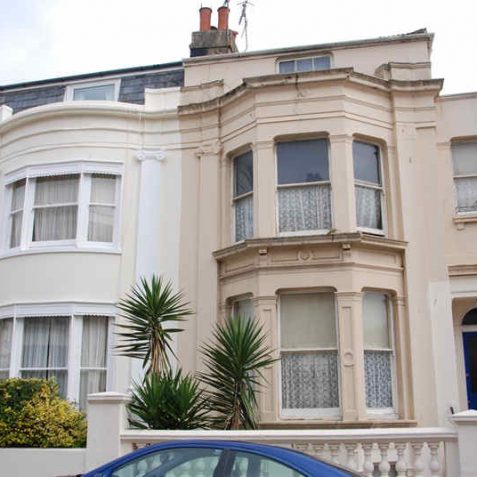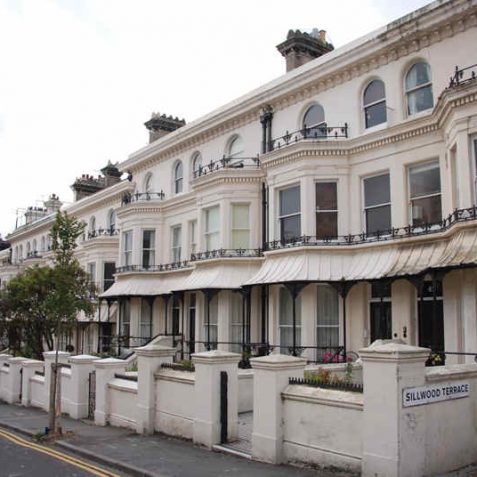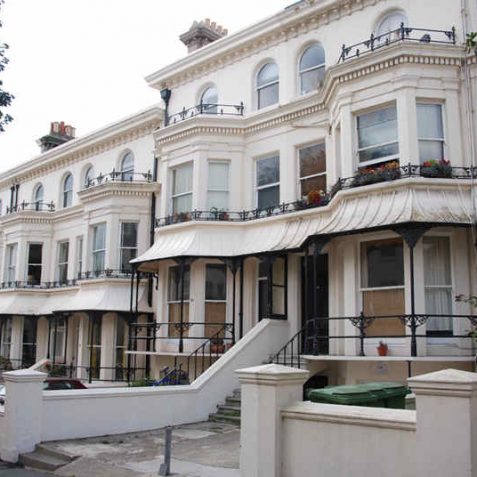Regency Square conservation area
Reproduced with permission from the Encyclopaedia of Brighton by Tim Carder, 1990
Please note that this text is an extract from a reference work written in 1990. As a result, some of the content may not reflect recent research, changes and events.
This outstanding conservation area, which stretches westwards from the Grand Hotel to the borough boundary, was developed principally in the 1810s and ’20s, and contains some of the finest examples of Brighton’s famous Regency architecture. However, the district of around 2,500 people now has many housing problems with its many multiply-occupied houses and bed-sits. The streets of particular interest in the area are detailed below, but see also “Bedford Hotel“, “Grand Hotel“, “King’s Road“, “Lower Esplanade“, “Metropole“, “Norfolk Hotel“, “West Pier“, and “Western Road“.
r) SILLWOOD ROAD: Known as Western Cottages until about 1870, the name was changed when the elegant listed terrace, nos.32-47, was erected by Thomas Lainson on the western side; the three-storey houses have ironwork balconies and verandahs. Nos.13-14 on the opposite side are also listed, while nos.9-10 are decorated with Ionic pilasters.
Any numerical cross-references in the text above refer to resources in the Sources and Bibliography section of the Encyclopaedia of Brighton by Tim Carder.








Comments about this page
The road was developed by the sister of Thomas Kemp, the builder of Kemp Town. His sister Ann (then Mrs Ann Sober) originally lived in a villa called Western Lodge built for her by A and H Wilds in about 1817 on the site of what is now Sillwood Terrace. She lived there till 1828, when she moved to her brother’s new project, Sussex Square, Kemp Town. The land to the south of the villa was originally Ann’s garden. In the 1820s she and Charles Busby collaborated on the building of a terrace of small houses along the eastern boundry – the Western Cottages refered to above. The artist John Constable and his family rented one of the houses when they made visits to Brighton for Mrs Constable’s health, telling friends they were staying at “No 9 Mrs Sober’s Gardens”. Constable painted a sketch from his lodgings in 1823 or 24 which shows Western Terrace and Western Lodge.
The view from the proposed No. 9 now Sillwood Road would not likely be the view as painted of the Gothic House in Western Terrace that was Sillwood Place. The angle is different and probably painted from the gardens which would have been opposite which are now occupied by the Thomas Lainsons Victorian houses
I looked into this very question a few years ago and at that time concluded the evidence was unfortunately inconclusive. There is no doubt that Sober’s Gardens was constructed on the eastern boundary of Ann Sober’s property, that Busby constructed a terrace of houses here, that the road was later named Western Buildings, Western Cottages before becoming Sillwood Road and that Constable resided in a house in that road whilst in Brighton. However, authorities on Busby cite that the Terrace of houses he built “were completed by July 1828: 1-13, Western Buildings, Sober’s Gardens, now renamed and renumbered 13-25, Sillwood Road” (C.A. Busby – The Regency Architect of Brighton and Hove by Neil Bingham, 1991). This view is entirely supported by Nicholas Antram and Richard Morrice in the Pevsner Architectural Guide to Brighton. If this is the case it might well accord with Martin’s remark about the Constable viewpoint, but the actual evidence that supports this contention is contradictory. A number of contemporary maps indicate the first buildings, apparently situated between Little Preston Street and Western Cottages (Sillwood Road), were to the north of the Terrace of houses now numbered 13-25. In my view, Western Cottages was built before Busby designed his Terrace of houses and is what is shown on early maps and listed in directories. Sober’s Gardens (or Western Buildings) was erected after 1826 and later renamed and numbered as a continuation of scheme of Western Cottages (ie: 13-25). This means that Constable probably resided at what is now 21, Sillwood Road, not the existing number 9. Regards, Andy.
In his letters from 9 Sobers Gardens Constable mentions more than once that he is next door to Mr Masquerier, a portrait painter who was then very well known. The deeds for 10 Sillwood Road (public access at Land Registry) show Mr Masquerier as the first owner of the house, in May 1824. At that time it was no 8 Sobers Gardens, Western Cottages and next door where the Constable family lodged was no 9. All the house numbers increased by 2 in the 1830s with new development at the top of the road so no 8 and 9 became 10 and 11. Western Cottages became Sillwood Road in 1872.
Hi Shan, my previous comments were made without the benefit of all of my research notes. Having since reacquainted myself with this subject matter, I am certain that Constable did not paint the Gothic house from the viewpoint of 11, Sillwood Road. The first problem is that the only reference to a house number in Sober’s Gardens is from the Constable letter; there is no other evidence that indicates how the nomenclature of the houses was arranged on the plot. The numbering of Western Cottages can be deduced from the 1826 Town Rate returns, in which James John Masquerier is listed at number 8, Western Cottages. However, the earlier Pigott’s 1824 map gives a very accurate plan of the footprint of Western Cottages. Superimposition onto a modern map makes it clear that the properties have altered, but moreover that the property boundaries are divided completely different to the later divisions. By far the most compelling evidence is that of the painting itself. The station point of the artist is aligned to the north of the gap that existed between Gothic House and the building to the south of it – if the artist were positioned any further south, he could not have seen the flank wall of that building. This unequivocally rules out number 11, Sillwood Road as being the position that the artist painted that picture from. The viewpoint of the painting implies that it was painted from a room located in the present number 6 or 7, Sillwood Road. The facts as presented by Constable could be interpreted that the numbering of Sober’s Gardens ran anti-clockwise around the plot (as there were also other buildings within the grounds of Western Lodge) and the later numbering of Western Cottages (then considered as a discrete terrace of houses) commenced at Western Road. Any viewpoint about the house numbering is based upon circumstantial evidence, but the viewpoint of the artist is unequivocal. Regards, Andy.
Hello Andy, I’m sure you are right about the viewpoint. As the Lainson houses had not been built and all the land in front of Western Cottages was garden, Constable could have wandered out and made a sketch from whatever viewpoint suited him so he presumably just chose the best angle. The numbering was always north to south though, deeds and directories cross check for several properties to confirm this. The terrace of houses built by Busby and cited in Neil Bingham’s 1981 book are indeed the present 13 -25, they were begun a couple of years after the present-day nos 3-12 and were originally intended to be known as Western Buildings. I have the deeds to number 14 which show it as 2 and then 12 Western Buildings, then 12 Western Cottages, then 14 Western Cottages and finally 14 Sillwood Road. Best wishes, Shan.
Hi again Shan, although I agree that Constable could have sketched from whatever viewpoint he desired, it has often been contended that he painted the Gothic house from his studio. By deconstructing the painting, it is evident that the actual station point of the artist was within the property line of Western Cottages (most probably modern number 6 or 7). I have not had sight of the property deeds, but do not believe they offer a satisfactory explanation of the numbering scheme for Sober’s Gardens. In 1822, when Ann Sobers decided to build properties within her garden, there were other buildings dotted around it other than the terrace of houses later named Western Cottages. I believe this terrace was completed in 1824 and Pigott’s plan makes it quite clear the divisions were not as the houses are today. However one enumerates the properties, there is an inconsistency in the numbering system, as the properties are set out on the Pigott plan. This calls into question your statement that the numbering was always north to south. As I have very carefully cross checked all of the directories and any other known occurrences of house numbering, my conclusion is different to your own. The first complete set of numbers is not until 1826 – earlier directories convey no numbers. I believe that Sober’s Gardens was a generic address from the outset (which included all of the other buildings upon the site). As the first few properties in Western Cottages were built, the original numbers were incremental to those buildings that were already complete in Sober’s Gardens. This did not necessarily reflect a north to south scheme. Within a few years Western Cottages was altered and discretely numbered from north to south from 1 to 10 as evidenced in the 1826 rates book. However, some confusion later abounds as the address was often given as Western Cottages, Sober’s Gardens. Thereafter I cannot fault your deductions about any renumbering. I would welcome any further comparison of notes on this matter, which might be best done off list. Regards, Andy.
While there is much current debate and research regarding renumbering in the Sillwood Road area, I shall be grateful if anyone can answer the following question: Was number 31 Sillwood STREET in 1865, still number 31 today? Thank you.
Hi Suzie, the original houses in Sillwood Street were built from around 1822 onwards and number 31 in 1865 stood where Fred Emery Court now stands. The original numbering went up the south side, starting from Little Preston Street and returned along the north side, the last house being numbered 34. The street was renumbered on 6th November, 1950 with odd numbers on one side and evens on the other. Regards, Andy.
Hi Andy, Thank you for sorting yet another query for me. Regards, Suzie.
Add a comment about this page